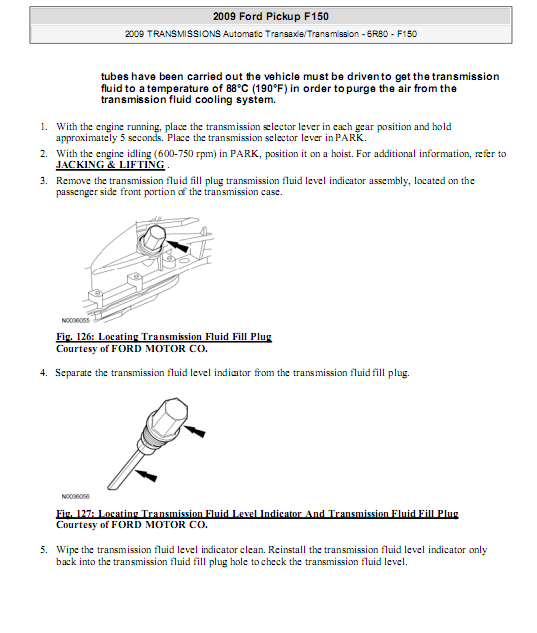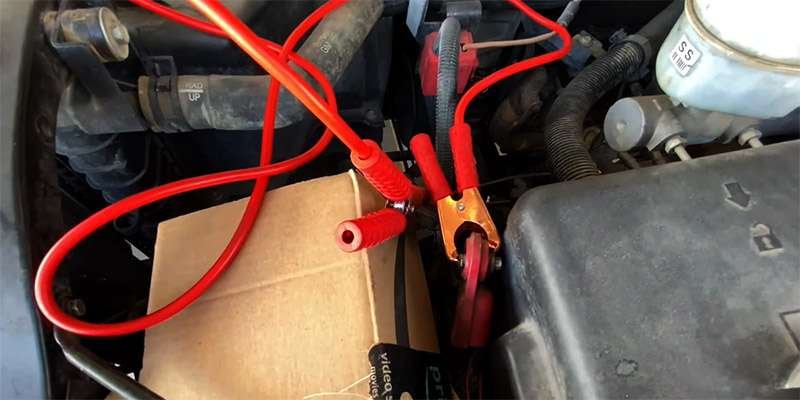To add transmission fluid to a Ford F150, park the truck on a level surface and warm up the engine. Open the hood and locate the transmission fluid dipstick to check the level.
Maintaining your Ford F150’s transmission fluid is crucial for the vehicle’s longevity and performance. A proper level of transmission fluid ensures smooth gear shifting and keeps the transmission system cool and lubricated. Regular checks can prevent the issues that come from low fluid levels, such as transmission overheating and gear slippage.
It’s important for owners to know the steps to check and refill their transmission fluid. This task doesn’t require special tools and can save time and money on maintenance. Always consult your F150’s owner’s manual for the recommended type and amount of transmission fluid, as using the wrong kind can lead to serious mechanical problems. Keep your Ford F150 in peak condition by performing this simple but essential maintenance task.

Credit: www.f150forum.com
Introduction To Transmission Fluid Maintenance
Maintaining your Ford F-150 includes regular checks on transmission fluid. It’s what keeps your gears shifting smoothly. Without proper care, you could face bigger problems down the road. Learn how it works and the signs that signal a refill is necessary.
The Role Of Transmission Fluid
Transmission fluid acts as a lubricant for all the moving parts inside your truck’s gearbox. Its job doesn’t end there. It also helps to:
- Cool the transmission components, preventing overheating
- Clean internal surfaces and protect metal surfaces from wear
- Enhance hydraulic pressure in automatic transmissions
- Reduce high temperatures and improve overall functioning
Indicators Your Ford F150 Needs Fluid
Your Ford F-150 will tell you when it’s time for more fluid. Look out for these signs:
| Indicator | Description |
|---|---|
| Gear Slippage | Gears change for no clear reason. |
| Hard Shifts | Shifting gears feels rough or jerky. |
| Delayed Engagement | Takes longer to move after starting. |
| Strange Noises | Whining or clunking when shifting gears. |
| Transmission Overheat | Dashboard light signals the transmission is too hot. |
| Fluid Leak | Reddish fluid under your truck. |
Recognize any of these symptoms? It might be time to check your fluid levels.
Tools And Materials Needed
Before you start pouring transmission fluid into your Ford F150, gather the necessary tools and materials. To make sure your maintenance goes smoothly, we’ll go through everything you need. This will save time and prevent mistakes.
List Of Essential Tools
Gearing up with the right tools is crucial.
- Funnel with a flexible neck: This helps to pour fluid without spills.
- Ratchet and socket set: Needed for removing the transmission fluid plug.
- Car jack and jack stands: To lift and secure your truck safely.
- Protective gloves: Keep your hands clean and safe.
- Clean rags: For wiping up any drips or spills.
- Drain pan: To catch old fluid during a fluid change if needed.
Choosing The Right Transmission Fluid
Selecting the correct fluid ensures your pickup runs smoothly.
- Check the owner’s manual: It lists the exact fluid type for your F150.
- Look for certification: Use fluids that meet Ford’s specifications.
- Consider truck’s age and model: Newer models may require different fluids than older ones.
- Transmission type matters: Automatic and manual transmissions use different fluids.
Preparation Steps
Keeping your Ford F150 in top shape means checking and changing fluids regularly. Adding transmission fluid is a key maintenance task. Before you start pouring in new fluid, it’s crucial to prepare properly. The right steps ensure safety and ease of access to your truck’s transmission system. Let’s walk through the necessary preparations.
Safety Measures Before Starting
Before you begin, consider safety the top priority. Wearing gloves and goggles can protect your hands and eyes. Find a well-ventilated area to work to keep fresh air circulating. Make sure your F150 is turned off to prevent any accidental startup. Have a clean funnel and a rag at hand to avoid spills and drips.
Vehicle Positioning For Optimal Access
Finding the ideal spot for your truck is essential for easy access to the transmission fluid dipstick and filler tube. Use a level surface to prevent the truck from rolling. Applying the parking brake adds extra security. If you need to raise the vehicle for better reach, use quality jack stands placed securely under the truck. Double-check stability before getting underneath your F150.

Credit: www.carcarekiosk.com
Locating The Transmission Fluid Dipstick
Maintaining your Ford F150 involves checking the transmission fluid regularly. The transmission fluid keeps the gears shifting smoothly. To get started, you need to find the transmission fluid dipstick. This is your guide to locate and read it.
Step-by-step Guide To Finding The Dipstick
- Ensure your F150 is on level ground.
- Let the engine run until it reaches normal operating temperature.
- Open the hood by pulling the release lever located inside your vehicle.
- Secure the hood with the prop rod.
- Locate the dipstick handle, which is typically yellow or red.
- Find the dipstick toward the back of the engine.
Note: For some models, there may not be a dipstick. Check your owner’s manual for specific details on your F150.
Understanding Dipstick Readings
Pulling out the dipstick reveals transmission fluid levels. Here’s how to read it:
- Clean the dipstick with a rag.
- Reinsert it fully, then pull it out again.
- Look for the “FULL” line.
- Ensure the fluid reaches this mark.
If the fluid is below the “FULL” line, add fluid as needed. The color should be bright red. Dark or burnt-smelling fluid means it’s time for a change.
Remember: Do not overfill. Excess fluid can cause issues.
Adding Transmission Fluid
Regular maintenance keeps your Ford F150 running smoothly. Adding transmission fluid is a key task that ensures your truck shifts gears without a hiccup. Doing it right can save you from costly repairs in the future. Let’s go step by step and top-up that transmission fluid with ease.
Procedure For Pouring New Fluid
To start, you’ll need to locate the transmission fluid dipstick. In most Ford F150 models, it’s near the back of the engine. Pull it out and wipe it clean for a proper read later.
- Warm up your truck by driving for a few minutes.
- Park on a level surface and leave the engine running.
- Pull out the dipstick and put a funnel in the tube.
- Pour the recommended transmission fluid slowly.
- Do not overfill; follow the manual for capacity.
Note: Use the type of fluid recommended in your owner’s manual to avoid damage.
Checking Levels And Topping Off
Once you’ve added the fluid, it’s time to check the level. Insert the dipstick back in, remove it, and examine the fluid level on the stick.
- The fluid should be at the “Full” mark on the dipstick.
- If it’s low, add more fluid gradually.
- Check the fluid color; it should be pink or red, not brown or black.
Tip: Recheck the level after driving to ensure it’s accurate. Fluid expands when warm, so the reading changes.
| Step | Action | Check |
|---|---|---|
| 1 | Remove dipstick | Clean for accurate level reading |
| 2 | Add fluid | Fill to “Full” mark |
| 3 | Drive & recheck | Confirm level post-expansion |
Post-addition Checks
After adding new transmission fluid to your Ford F150, it’s crucial to perform post-addition checks. They ensure everything runs smoothly. This step is like a health check-up for your truck’s transmission system.
Verifying Correct Fluid Levels
Checking the fluid level is your next move. Ignoring this can harm your truck. You must confirm the transmission fluid reaches the marked ‘full’ line on the dipstick. Here’s what you do:
- Start the engine – Let it warm up.
- Pull out the dipstick – Wipe it clean first.
- Re-insert the dipstick – Then remove it once more.
- Check where the fluid hits the mark.
- If low, add more fluid in small amounts.
Repeat these steps until you hit the sweet spot.
Testing The Vehicle After Fluid Addition
Once levels are good, test your truck:
- Drive around briefly – Look for smooth shifts.
- Listen for odd sounds – Whining or clunking isn’t good.
- Feel the gear changes – They should be seamless.
If you notice anything off, consult a professional. Regular checks keep your transmission healthy. Your Ford F150 will thank you with a longer life and better performance.
Maintenance Tips For Longevity
Ensuring your Ford F150 runs smoothly for years involves routine maintenance. Among the most critical aspects is taking care of the transmission. A properly maintained transmission can prevent costly repairs and extend the life of your truck.
Regular Check-up Intervals
Consistent checks keep your transmission in top shape. Refer to your owner’s manual for specific intervals. A common recommendation is a check-up every 30,000 to 60,000 miles. This proactive approach ensures long-term health for your F150’s transmission.
- Monthly: Verify fluid level and color.
- Semi-annually: Inspect for leaks.
- Per manual: Flush and replace fluid.
Signs Of Transmission Wear
Stay vigilant for early signs of wear, which can include:
| Symptom | Possible Cause |
|---|---|
| Slipping Gears | Low fluid or worn transmission bands. |
| Rough Shifts | Damaged gear synchronizers. |
| Fluid Leaks | Seal wear or gasket failure. |
| Unusual Noises | Bearings or gear damage. |
| Warning Light | Sensor signal indicating an issue. |
Address any concerns promptly with a professional mechanic.

Credit: www.dieself150forum.com
Frequently Asked Questions For How To Add Transmission Fluid In Ford F150
How Do I Know If My F150 Transmission Fluid Is Low?
To check if your F150’s transmission fluid is low, monitor for symptoms like erratic shifting, delayed gear engagement, or a transmission warning light. For a more direct method, examine the fluid level using the dipstick while the engine is running and warmed up.
What Is The Proper Way To Add Transmission Fluid?
Check your vehicle’s manual to locate the transmission fluid dipstick. With the engine warm and running, pull the dipstick out and wipe it clean. Reinsert it fully and pull out again to check the fluid level. Add the recommended transmission fluid slowly, if needed, using a funnel.
Where Is The Transmission Fluid On A Ford F150?
The transmission fluid in a Ford F150 is typically found in the transmission fluid dipstick tube. Check your owner’s manual for the exact location and identification.
Do You Add Transmission Fluid With Truck On Or Off?
To add transmission fluid, start the truck and let it reach operating temperature. Then, with the engine idling, proceed to add fluid.
Conclusion
Maintaining the transmission fluid in your Ford F150 ensures longevity and performance. By following the steps outlined, you can easily top up the fluid yourself. Always check your owner’s manual for specifics to your model. Regular maintenance keeps your F150 running smoothly, preventing costly repairs down the road.
Stay proactive about vehicle care!











